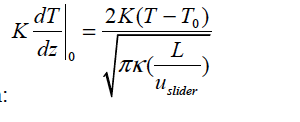Shell Energy Source Sliding Contact#
Shell Energy Source Sliding_Contact = {model_name} <float_list>
Description / Usage#
This card activates a heat source (or sink, as it were) in the shell_energy equation. The functional form of this source/sink is a sliding contact model derived in the frame-of-reference of the slider on a stationary surface, so that the surface is moving in the simulation. In this case, the conditions for the flux vary from the leading edge to the trailing edge of the slider as a thermal boundary layer builds up. Think of this as a hot slider moving over a cold stationary wall, so that the flux at the leading edge of the slider into the cold wall will be larger, due to a steeper thermal boundary layer. Clearly the contact time will play a role. Currently two models {model_name} are permissible:
LOCAL_CONTACT |
This model invokes the following functional form: Commensurately there are seven floats required:
|

AVERAGE_CONTACT |
This model invokes the following functional form: Commensurately there are seven floats required:
|

Examples#
Following is a sample card:
Shell Energy Source Sliding_Contact = LOCAL_CONTACT {L= 2.5} {t_r=20} {t_cond_cu_cgs} {density_cu_cgs} {heat_capacity_cu_cgs} {delta_L = 0.1} {leading_edge_coordx = 2.5}
Technical Discussion#
Technical Discussion This boundary condition was derived using the analytical solution for heat conduction into an infinite slab, as derived by Carslaw and Jaeger. The modification here is that the temperature source accommodates a motion relative to the substrate, which is what leads to the need to segment the slider into bins over which a local heat flux solution is derived.
NOTE: If this card is used and there is no upper-wall or lower wall sliding motion, and error is thrown.
